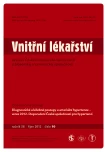Hypoglycaemia – a phenomenon over which modern diabetology manages to prevail
Authors:
Š. Svačina
Authors‘ workplace:
III. interní klinika 1. lékařské fakulty UK a VFN Praha, přednosta prof. MUDr. Štěpán Svačina, DrSc., MBA
Published in:
Vnitř Lék 2012; 58(10): 751-754
Category:
Reviews
Overview
Hypoglycaemia is considered to be the most significant complication when treating diabetes. The most important is its association with cardiovascular risk. Rigorous self-monitoring, lifestyle changes and the use of insulin analogues reduce the risk significantly in type 1 diabetes patients. Combined insulin and incretin therapy appears to be useful. Individualized therapy and incretin treatment in particular represent considerable risk reduction in type 2 diabetes patients. It is crucial to change therapy in a patient who underwent hypoglycaemia. Modern antidiabetic therapy helps to surmount the risk of hypoglacaemia and it is possible at any stage of type 2 diabetes treatment to select therapy with lover risk of hypoglacaemia: incretin therapy is the most suitable following metformin treatment failure, incretin analogues are the most suitable when oral antidiabetic agents fail, and insulin analogues are the most appropriate when insulin therapy is to be initiated.
Key words:
cardiovascular risk – insulin therapy – incretin therapy – oral antidiabetic medication – insulin analogues
Sources
1. Charvát J. Hypoglykémie. In: Pelnář J et al (eds). Bezvědomí a náhlé poruchy vědomí. Praha: Vědecké nakladatelství J. Tožičky 1936 : 81–90.
2. Šmahelová A. Akutní komplikace diabetu. Praha: Triton 2006.
3. Frier BM, Schernthaner G, Heller SR. Hypoglycemia and cardiovascular risks. Diabetes Care 2001; 34 (Suppl 2): S132–S137.
4. Giménez M, Gilabert R, Monteagudo J et al. Repeated episodes of hypoglycemia as a potential aggravating factor for preclinical atherosclerosis in subjects with type 1 diabetes. Diabetes Care 2011; 34 : 198–203.
5. Jin WL, Azuma K, Mita T et al. Repetitive hypoglycaemia increases serum adrenaline and induces monocyte adhesion to the endothelium in rat thoracic aorta. Diabetologia 2011; 54 : 1921–1929.
6. Castaldo E, Sabato D, Lauro D et al. Hypoglycemia assessed by continuous glucose monitoring is associated with preclinical atherosclerosis in individuals with impaired glucose tolerance. PLoS One 2011; 6: e28312.
7. McCrimmon RJ, Ryan CM, Frier BM. Diabetes and cognitive dysfunction. Lancet 2012; 379 : 2291–2299.
8. Tůma I. Diabetes a kognitivní poruchy. Vnitř Lék 2007; 53 : 486–488.
9. Hermansen K, Fontaine P, Kukolja KK et al. Insulin analogues (insulin detemir and insulin aspart) versus traditional human insulins (NPH insulin and regular human insulin) in basal-bolus therapy for patients with type 1 diabetes. Diabetologia 2004; 47 : 622–629.
10. Thalange N, Bereket A, Larsen J et al. Treatment with insulin detemir or NPH insulin in children aged 2–5 yr with type 1 diabetes mellitus. Pediatr Diabetes 2011; 12 : 632–641.
11. Kristensen PL, Hansen LS, Jespersen MJ et al. Insulin analogues and severe hypoglycaemia in type 1 diabetes. Diabetes Res Clin Pract 2012; 96 : 17–23.
12. Kristensen PL, Pedersen-Bjergaard U, Beck-Nielsen H et al. A prospective randomised cross-over study of the effect of insulin analogues and human insulin on the frequency of severe hypoglycaemia in patients with type 1 diabetes and recurrent hypoglycaemia (the HypoAna trial): study rationale and design. BMC Endocr Disord 2012; 12 : 10.
13. Wang F, Surh J, Kaur M. Insulin degludec as an ultralong-acting basal insulin once a day: a systematic review. Diabetes Metab Syndr Obes 2012; 5 : 191–204.
14. Lind M, Jendle J, Torffvit O et al. Glucagon--like peptide 1 (GLP-1) analogue combined with insulin reduces HbA1c and weight with low risk of hypoglycemia and high treatment satisfaction. Prim Care Diabetes 2012; 6 : 41–46.
15. Inzucchi SE, Bergenstal RM, Buse JB et al. Management of hyperglycaemia in type 2 diabetes: a patient-centered approach. Position statement of the American Diabetes Association (ADA) and the European Association for the Study of Diabetes (EASD). Diabetologia 2012; 55 : 1577–1596.
16. Marx N, Kern W. Sind Hypoglykämien bei Typ-2-Diabetes ein bedeutsames Risiko? Pro Contra Dtsch Med Wochenschr 2012; 137 : 1007.
17. Karagiannis T, Paschos P, Paletas K et al. Dipeptidyl peptidase-4 inhibitors for treatment of type 2 diabetes mellitus in the clinical setting: systematic review and meta-analysis. BMJ 2012; 344: e1369.
18. Abdul-Ghani MA, Williams K, Kanat M et al. Insulin Versus GLP-1 Analogues in Poorly Controlled Type 2 Diabetic Subjects on Oral Therapy A Meta Analysis. J Endocrinol Invest 2012; 18. Epub ahead of print.
19. Khunti K, Caputo S, Damci T et al. The safety and efficacy of adding once-daily insulin detemir to oral hypoglycaemic agents in patients with type 2 diabetes in a clinical practice setting in ten countries. Diabetes Obes Metab 2012; 25. Epub ahead of print.
20. Hemmingsen B, Lund SS, Gluud C et al. Intensive glycaemic control for patients with type 2 diabetes: systematic review with meta-analysis and trial sequential analysis of randomised clinical trials. BMJ 2011; 343: d6898.
21. Philis-Tsimikas A, Charpentier G, Clauson P et al. Comparison of once-daily insulin detemir with NPH insulin added to a regimen of oral antidiabetic drugs in poorly controlled type 2 diabetes. Clin Ther 2006; 28 : 1569–1581.
22. Hermansen K, Davies M, Derezinski T et al. A 26-week, randomized, parallel, treat-to-target trial comparing insulin detemir with NPH insulin as add-on therapy to oral glucose-lowering drugs in insulin-naive people with type 2 diabetes. Diabetes Care 2006; 29 : 1269–1274.
Labels
Diabetology Endocrinology Internal medicineArticle was published in
Internal Medicine

2012 Issue 10
Most read in this issue
- Vitamin C and its physiological role with respect to the components of the immune system
- Sarcoidosis – diagnostics, prognosis and therapy. A retrospective analysis
- Acute myocardial infarction in young patients – severe failures in the system of acute and secondary care
- Febrile pancytopenia and hepatosplenomegaly as leading symptoms of visceral leishmaniasis
